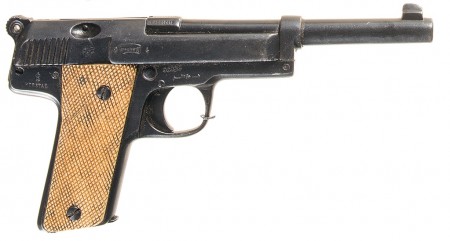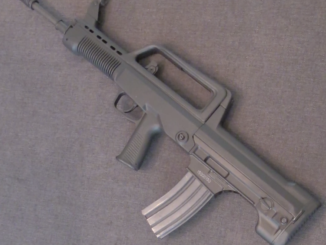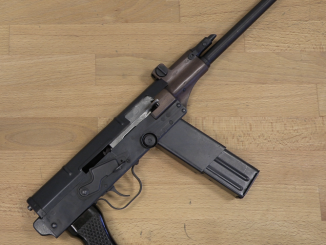So this past weekend was a Regional auction at the Rock Island Auction house, which I neglected to post about beforehand. The Regional auctions are the ones with typically lots of less valuable guns packaged up into lots of 4, 5, 6, or more. I put in bids on a bunch of lots, but unfortunately my hereditary Scottish stinginess won out over my hoplokleptomania and I didn’t end up winning any of them**. So instead of posting today to gloat about my new toys, I figured I’d point out some of the neat stuff that was up for sale that someone else bought.
First off, and one I’m particularly disappointed to have lost out on, is another of the Chinese Mystery Pistols in .32 ACP. These show up from time to time, usually in either .32 or 7.62×25 caliber, and with design elements from C96 Mausers, 1900 Brownings, and anything else that the blacksmith-cum-gunsmith may have seen before he started building. The markings are also generally a jovial mix-n-match of whatever logos and Latin-alphabet words looked interesting (this one has “Herstal”, “Nationale”, and a Mauser banner).

Now, this particular pistol was in a lot with a Steyr 1907 (not cheap) and a very rare Isard 1911 knockoff made during the Spanish Civil War. The lot price went through the roof, and I suspect it was because of an SCW collector who just had to have the Isard. If that person happens to be reading this and would be interested in offloading this Chinese contraption, please let me know – I want one of them!
Anyway, another rarely seem item that came up was a .22 caliber trainer for the Egyptian Hakim rifle, called the Tahrir. I’ve done a video with the air rifle Hakim trainer, but never handled one designed for rimfire cartridges (and a semiauto, it appears). Would have been great to get that one, but alas it also slipped through my fingers.

Lastly, I’ll mention one that I kinda knew I wouldn’t be able to win, because it was just too pricey, and bundled with some other pretty valuable pieces: a Lee Enfield Carbine Mk I, issued to the Royal Irish Constabulary. An Enfield truly worthy of drooling over! This one was dated 1895, so it was a legal antique on top of everything else. Alas, it was coupled with a vz52/57 and a handful of other guns, and I just couldn’t afford the whole package.

Fortunately, there’s always next time!
** So, I wrote this after completely striking out on bids over the phone Saturday afternoon – but then Sunday one of my sealed internet bids won, on a lot of Swiss straight-pulls (because I still need a K11 carbine). But those aren’t particularly exotic, so I’m leaving the post as-is.




“…blacksmith-cum-gunsmith …” I like that, it fits seamlessly into general term ‘gun-porn’-)))).
Actually, from historical prospective – early gunsmiths may have originated from blacksmiths. Or whitesmiths… not sure. Probably both.
The development of gunsmithing in Scotland seems to have come via locksmithing rather than blacksmithing. Parish records from Stirling and Doune seem to indicate a shift from “locksmith” to “dag maker” in the late 17th C.. (A Dag was the early Scots name for a pistol)…
This of course may be a local variation, the Scots alwsys seeming to have a preference for swords and pistols rather than muskets.. something the Scots-Irish took with then to the New World perhaps..?
Something I must write up more fully when I get the chance..!
Please do! I see the firearms (and weapons in general) development on British Isles as unique to some degree, although they certainly had contact with rest of Europe.
There certainly seems to have been some mobility between locksmiths and gun smiths,
A particularly important centre for this in terms of development of modern machine tools and measurement devices, was Joseph Brammah’s locksmith business and its poaching of a very young Henry Maudslay from Enfield arsenal.
Apologies, that should be Woolwich Arsenal
RIA’s lot system gets me every time. Buying 6 guns to get one you want, have them shipped, and then having to sell 5 over the next year is a lot of hassle and tied up money. Not talking issues due to the lack of an FFL, theoretically buying with no intend to keep seems awfully close to dealing.
Hey Ian, look on the bright side. By not buying anything , you can use the money you saved to purchase some decent screwdrivers!! (See Remington 8 video)
I like the pistol. Kinda looks like a long-barrelled Baretta. Sorry for the poor spelling. Ian is right. Kinda neat! Better luck next time! mikey
Well, having won those Swiss rifles, you did better than I. None of my bids won, in fact most went for over double the upper estimate.
for the Chinese copy: who needs a rear sight?
I’ve also seen one with a rear tangent sight on which the actual sight notch was obscured by the rest of the slide.
Actually it has a rear sight: a tiny-teeny rigid notch at the rear edge of the barrel. From the right side view shown above it looks like there’s nothing there, but if you take a look at the left side view (RIA Regional Auction 22,23,24 February 2014 Item #1527) it seems it’s still there 🙂 Perhaps they lost it in turning the pistol to the other side…
I like your term blacksmith-cum-gunsmith above.
When I was in the RVN, I had chance to meet a guy who made “Smith and Wesson” .38 special revolvers with some old files, drill bits and much elbow grease because he did not have any power tools, or electricity service! His shop was across the street from our “Transit hotel” in Da Nang.
As soon as you looked close, you could see that they were obviously knock-offs, but his customers did not care and they worked well enough, if you do not mind occasional lead spitting and a very casual form of rifling.
That Chinese .32 reminds me of the .380 version of the .22 High Standard used by the OSS in WW2. The RIC Enfield (and exactly what is the difference between the RIC and the RUC, anyway? I know a lot of Republican ballads that mention the Royal Ulster Constabulary, and not in a flattering way.) Wonder what the sidearm of choice was for the RIC and RUC in 1895 – were they still using the solid-frame .442/ .450 RUC Webleys?
That RIC Enfield will have had an interesting life, from 1895 to now… The RUC Jim were the RIC after Ireland became a Republic, but Ulster – Northern Ireland stayed British. Prior to this the Royal Irish Constabulary included the Police in Ulster because Ireland was a single entity within the British empire sort of thing. The Republic had the Garda then as Police so the only “Royal” constabulary was in the remaining British part of Ireland, northern Ireland. I know before the RUC became the Police service of Northern Ireland fairly recently they used Ruger revolvers, and rifles unlike the mainland U.K prior to that I assume they used Webley’s and Enfields of various configurations such as you mention onwards. By the 60’s the Irish “cause” had become pretty much caught up in the cold war, and there was lots of intrigue all round sectarianism aside but on the ground the Police still had to deal with burglars etc and weren’t the paramilitary organization they were made out to be in some quarters “well not all of them” anyway.
I worked with a guy who had been a cop in Belfast until the early 80’s. he was offered a transfer to the UK as his name appeared on a number of PIRA hit lists. I met him in the late 90’s after he had been invalided out of a UK Police force, ironically he was severely injured arresting a criminal for shoplifting.
We discussed Police weapons on a couple of occasions, he told me before he joined the RUC they used Webley .38 revolvers which were then phased out and replaced with Smith & Wesson .38 revolvers and then later Rugers. They had a number of Lee-Enfield rifles when he joined, he wasn’t sure if they were .303 or converted to 7.62 as he had never been trained to use them.
All RUC officers were required to pass a firearms test before being able to work the streets, any who didn’t were either restricted to admin roles, offered the opportunity to seek a transfer to a mainland force or were free to leave the Police.
I’ve run across a ton of songs and books about the Troubles, from both the Republican and Loyalist sides. Frankly, after all the centuries of history, the peace that has held in the North for over 20 years now gives hope for a lot of other seemingly intractable conflicts. When I was stationed in Connecticut in the 70s I spent a lot of time in Boston and New York and there was no shortage of neighborhood bars that had Wolf Tones on the jukebox and the “widows and orphans” collection for NORAID on the bar. I figured that by the time of Independence or Partition or whatever you called it in the 20s the Webley breaktops (both .455 and .38 S&W) were the norm… it is just that high on my “I wish they would remake” list is the solid-frame loading-gate DA Webley Bulldog, of which there was a model (pretty sure it was in .442) made especially for the RIC. It’s generally believed that Custer was carrying a pair of RIC Webleys when he miscalculated the numbers of the opposition.
Actually, my great-grandfather was killed at Little Big Horn. He had his RV parked in a campground next to the battle, and the daft old bastard walked over to tell them to keep the noise down.
I picked up an RIC carbine (dated 1898) at the last big auction here in Mattoon. It wasn’t cheap, but I wanted it more than the other guy.
I really need to go to an RIA auction at some point. Perhaps after I rob a bank.